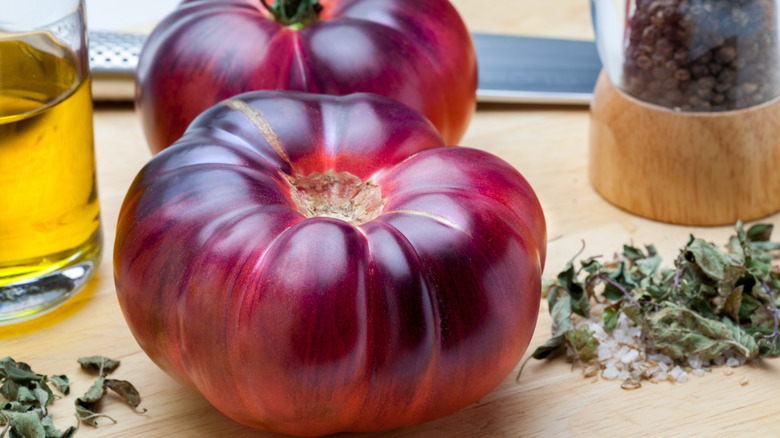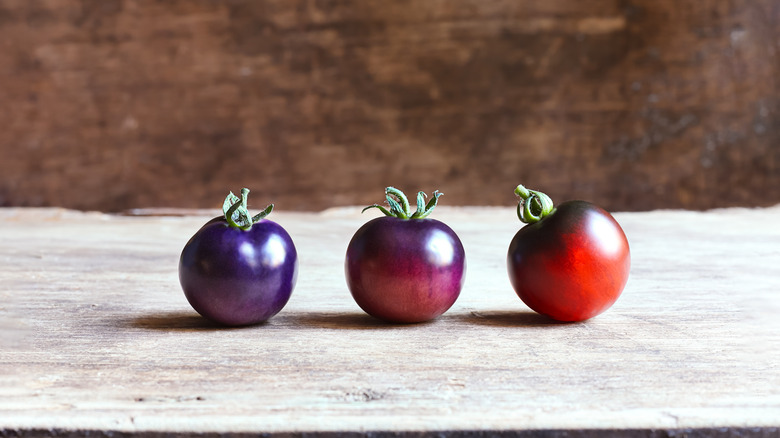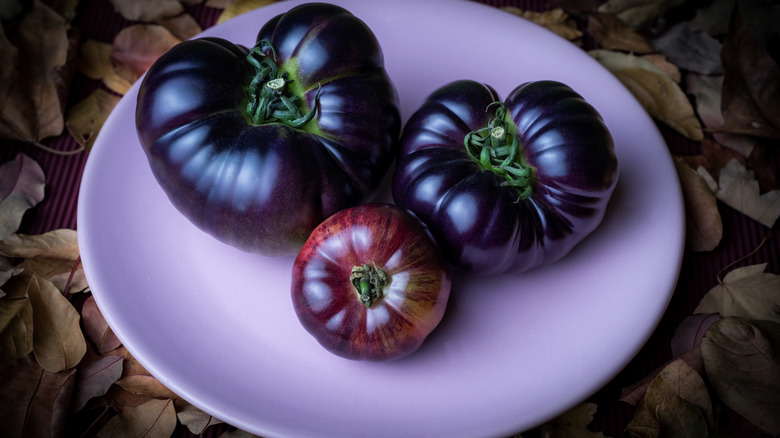How Do Blue Tomatoes Get Their Color, And What Do They Taste Like?
There is much to unlearn about food when emerging facts change our preconceived notions. For example, bananas and tomatoes are berries, but strawberries are not because, by botanical definition, berries have seeds that grow inside. Some may even be surprised that oranges are often not orange at all and typically remain green when grown in a tropical climate. Now we must also adjust the misconception that ripe tomatoes are always red.
Tomatoes can be shades of blue depending on the variety. To be more specific, the tomato's skin color can be a dark blue hue that is almost black or purple when ripe, while the flesh inside is typically red. Blue tomatoes get their unique color from the high levels of anthocyanin in their skin, a group of deep red, purple, and blue pigments also found in eggplant and cherries.
Anthocyanins have health benefits and are known for their antimicrobial and anti-inflammatory properties. The United States National Center for Biotechnology Information states that anthocyanins extracted from edible plants are potential pharmaceutical ingredients, which explains the interest from scientists and horticulturists to see if they can amplify them in a new variety of fruit or vegetable.
Indigo Rose is the pioneer blue tomato
One of the reasons why we can't easily find blue tomatoes in a supermarket or even a farmers' market that might even have heirloom tomatoes is that most varieties remain a niche species. Growing them requires selective breeding, and only some farmers and gardening enthusiasts are aware of commercial varieties like the aptly named Indigo Rose or the more interestingly named Dancing With Smurfs Tomato. The commercial variety of the Indigo Rose started at Oregon State University (OSU) in 2012 when Dr. Jim Myers, a professor in the OSU horticulture department, wanted to breed species with high levels of antioxidants or anthocyanin. He succeeded, and this variety became available in seed catalogs for home gardens.
But Dr. Myers acknowledges that the Indigo Rose story started in the 1960s when two breeders first crossed-cultivated common species with wild tomato cultivars with high amounts of anthocyanin from Chile and the Galapagos Islands. As the story goes, the early versions were not very tasty, and it took some trial and error to get a variety that had the desired flavor and level of anthocyanin. But a decade later, the question of taste remains a sticking point. People who grow Indigo Rose tomatoes at home have mixed reviews, ranging from "beautiful on the vine, but underwhelming on the plate" to "delicious and bold with a unique floral taste."
But there are other varieties too
Wild Boar Farms in California sells a range of seeds, which includes Blue Beauty ("medium-large fruit, meaty pink beefsteak with a dark blue top"), Blue Chocolate ("chocolate brown with black anthocyanin tops"), and Black Beauty (a "dark, meaty, very rich fleshed tomato with extreme anthocyanin"). Like the reviews for Indigo Rose, opinions tend to be mixed and boil down to personal taste and the home gardener's botanical knowledge.
One reason for this may be that gauging when blue tomatoes are ripe can be difficult. With a red one, it's fairly easy: Green is unripe, and red or yellow is ripe. However, blue tomatoes play by different rules. "The young blue tomato fruit looks amethyst purple and turns a dark purple-black as it matures, with the skin of the darkest ones becoming almost jet black," says Bradley Gates, the grower and breeder behind Wild Boar Farms (via SFGate).
Since the purple-black color only develops where the skin is exposed to the sun, the trick here is to check the bottom of the tomato to see if it has darkened. If it has, pluck it off the vine and remember that tomatoes are best kept in a glass bowl on the kitchen counter and never in a refrigerator.


